In 1981, fast-flowing streams of lava poured down the north-western flank of Mt Etna on Sicily, narrowly missing the town of Randazzo. The lava solidified into a jagged no man’s land, then slowly greened as a variety of plants found pockets of fertile soil. Sicilian Partridges Alectoris whitakeri found this habitat very much to their liking, and that was why Arnoud and René spent the night there in April 2007. Some orchards narrowly missed by the lava contained many Eurasian Scops Owls Otus scops. Nearby, cavities in the lava offered perfect nesting opportunities for Cucumiaus Athene noctua. In CD1-58, you can hear several males hooting at once.
CD1-58: Cucumiau Athene noctua Northern slopes of Mt Etna, Castiglione, Sicily, Italy, 20:20, 21 April 2007. Hooting of several males. Background: hooting and (from 0:22) twiu calls of a Eurasian Scops Owl Otus scops. 07.017.AB.03036.12
Three years later I visited the same area on a frustrating quest to record the sounds of Lanner Falcons Falco biarmicus. Andrea Corso, top birder and all-round obsessive zoologist, had entrusted me to wildlife sculptor Nino Patti. Nino could only stay with me for short periods between working at a museum in Catania and looking after his then 99-year-old grandmother, so I had to drive behind him in my hire car. I could only just keep up. Nino lives in the village of Malvagna, on the northern side of the same broad valley where Arnoud had been three years previously. Elevated on a ridge leading to the Peloritani range, it is a great place to make bird sculptures, offering stunning views over the surrounding countryside and south towards Mt Etna.
Unfortunately the owls were quiet during that visit, probably because they were incubating. By the time I returned with Andrea a year later, Nino’s grandmother had completed her century and I had recorded Lanners elsewhere. It was late March and this time the owls were in full voice. The male in CD1-59 hooted non-stop for hours.
CD1-59: Cucumiau Athene noctua Malvagna, Sicily, Italy, 20:49, 23 March 2011. Hooting of a male. 110323.MR.204920.01
While some sounds of Cucumiau are very distinctive, its hooting is very similar to that of Little Owl. In southern Italy I could hear no difference from the Little Owls of northern Europe. However, Cucumiau has several subspecies, and subtle differences started to emerge as I listened to recordings of some of the others. In the following set of recordings, Arnoud takes us clockwise around the Mediterranean, via subspecies noctua in Bulgaria and lilith in southern Turkey, ending up with glaux and saharae in Morocco. There is a gradual change from rising to falling pitch in the hoots.
In CD1-60 we are in a small town in southern Bulgaria. The recording starts with rising hoots. At 0:36 the male changes perch, causing one hoot to be modulated by its wingbeats. From then on, he hoots more intensely and the contour of each hoot levels out.
CD1-60: Cucumiau Athene noctua noctua Madzharovo, Haskovo, Bulgaria, 01:26, 26 June 2009. Hooting of a male. Background: Woodlark Lullula arborea. 090626. AB.012608.01
In CD1-61, we are in south-eastern Turkey, listening to subspecies lilith. During the stillness just before a desert storm, a male hoots into a great emptiness of rolling, herb-carpeted hills. As the tension builds, each hoot’s inflection gradually changes from rising to slightly falling. Although not unheard of in Little Owl, this is certainly more common in Cucumiau, especially east and south of the Mediterranean.
CD1-61: Cucumiau Athene noctua lilith Payamlı Koyu, Şanlıurfa, Turkey, 04:51, 17 June 2009. Hooting of a male. Background: domestic fowl Gallus gallus domesticus, See see Partridge Ammoperdix griseogularis, Collared Dove Streptopelia decaocto, European Turtle Dove S turtur, Crested Lark Galerida cristata and Desert Finch Rhodospiza obsoleta. 090617.AB.045128.11
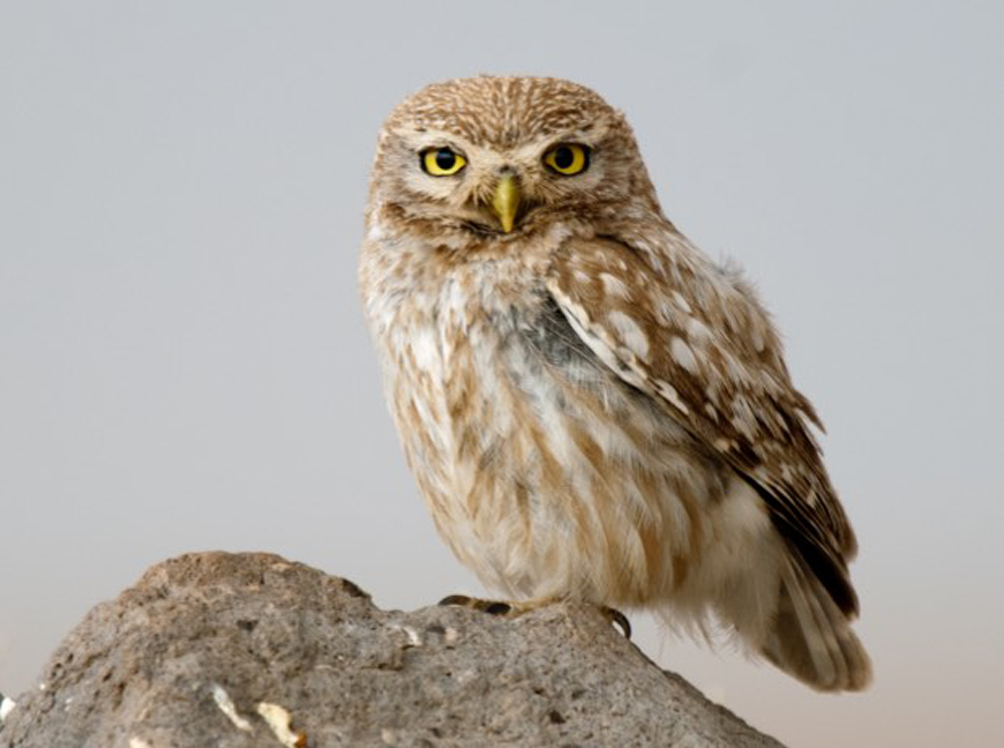
Cucumiau Athene noctua lilith, male, Payamlı Koyu, Şanlıurfa, Turkey, 17 June 2009 (Arnoud B van den Berg). Same bird as in CD1-61.
In CD1-62, we are in a small fortified market town in southern Morocco, situated in the broad valley between the High Atlas and the Anti-Atlas mountain ranges. A male glaux hoots from a pole sticking out of a roof, close to the old city wall. His hoots are strongly descending, except for a lower one about halfway through the series. Arnoud made several recordings of this male and in all of them, descending hoots were the rule.
CD1-62: Cucumiau Athene noctua glaux Taroudant, Souss, Morocco, 23:54, 11 April 2010. Hooting of a male. 100411.AB.235431.21
In CD1-63, we have moved about 90 km southwest to Oued Massa on the Atlantic coast. It is mid-morning, and a male saharae is hooting from a lone tree in sandy agricultural land between rocky desert and a brackish river. Although the first hoot is rising, most of those that follow are descending, at least in their overall contour.
CD1-63: Cucumiau Athene noctua saharae Oued Massa, Agadir, Morocco, 09:25, 6 April 2004. Hooting of a male. Background: Collared Dove Streptopelia decaocto, Common Bulbul Pycnonotus barbatus, yellow wagtail Motacilla, Eurasian Reed Warbler Acrocephalus scirpaceus, Zitting Cisticola Cisticola juncidis, European Goldfinch Carduelis carduelis, Common Linnet Linaria cannabina, European Greenfinch Chloris chloris and Corn Bunting Emberiza calandra. 04.008.AB.02947.11
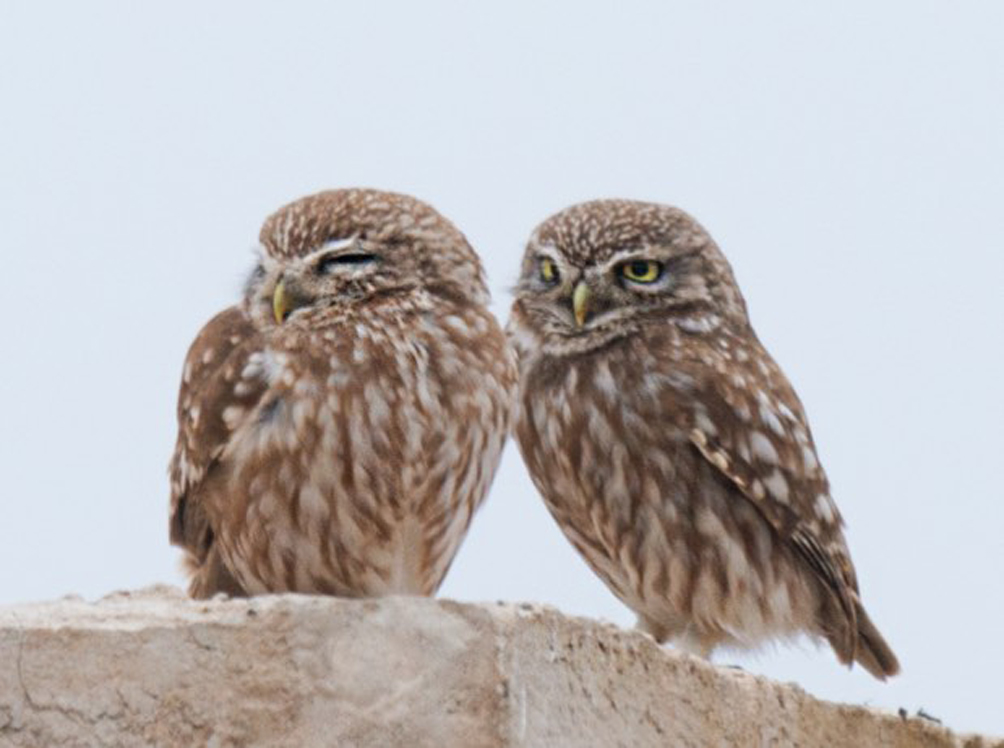
Cucumiau Athene noctua saharae, Oued Massa, Morocco, 20 March 2014 (Arnoud B van den Berg). Same site as in CD1-63 & 67 but in different year.
One of the people who helped me most during my travels in Italy had better remain nameless. It was during secret outdoor trysts that he discovered some of the best places for me to sound record Cucumiaus. A very quiet lane with a ruined farm building and a small copse proved perfect for both activities. Based on our anonymous friend’s suggestion, my friends and I went there several times to make recordings.
If nothing happened for too long, Andrea would encourage the owls with some excellent imitations. Their first reaction was usually hooting, but this would often progress towards excitement calls. When these escalated into aggressive song, they began to sound very different from Little Owl.
As Cucumiau’s name suggests, every loud MIAU of the aggressive song is preceded by one or two low, chugging sounds: cucuMIAU, cucuMIAU, cucuMIAU…. By contrast, Little Owl has an aggressive song composed of just a single type of sound: MIAU, MIAU, MIAU etc. It was while listening to the ‘lover’s lane’ pair (CD1-64) that I first noticed the difference.
CD1-64: Cucumiau Athene noctua San Giovanni in Galdo, Molise, Italy, 18:58, 18 March 2011. Aggressive song and excitement calls of a pair. Background: Italian Tree Frog Hyla intermedia. 110318.MR.185819.01
At first I thought I had discovered something unique to Italian little owls. Later, when I checked recordings of other taxa, I learned that vidalii is the only Western Palearctic Athene owl that lacks chugging notes in its aggressive song.
Since aggressive song is arguably the most important long distance signal in their repertoire, this striking difference seems to me to be highly significant.
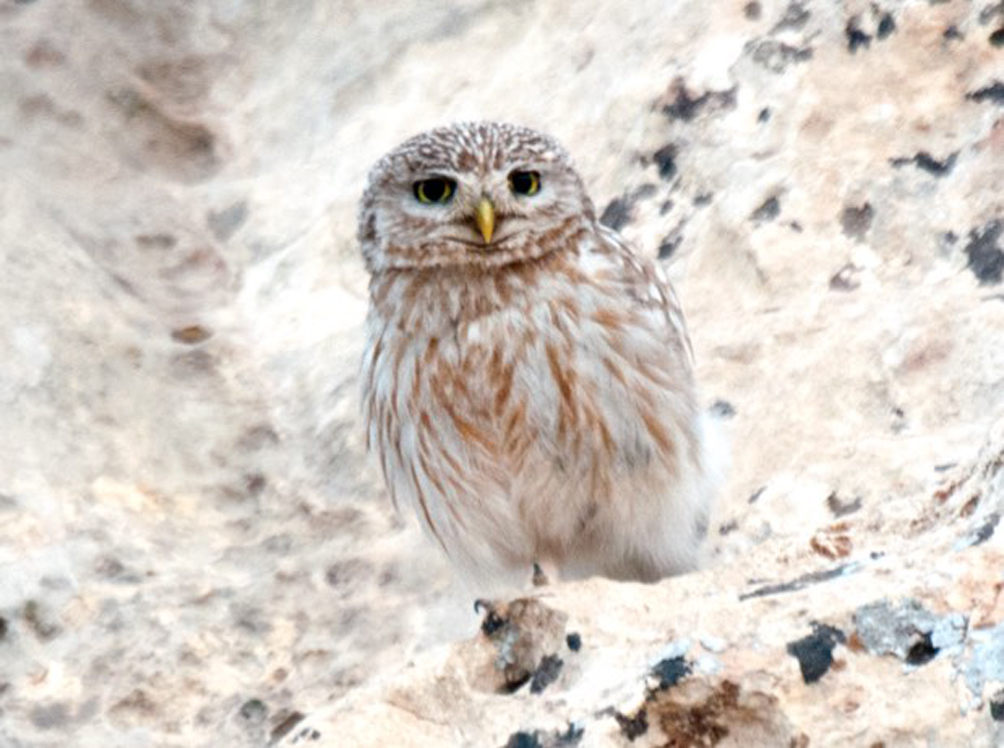
Cucumiau Athene noctua lilith, adult, Kızılkuyu, Şanlıurfa (near Syrian border), Turkey, 12 June 2009 (Arnoud B van den Berg). Same bird as in CD1-65.
Aggressive song follows broadly the same pattern in all subspecies of Cucumiau. CD1-65, CD1-66 and CD1-67 provide examples of subspecies lilith, glaux and saharae. Note that in all three there are also some strongly descending excitement calls. Just as with hooting, this descending contour seems to become steeper as we go clockwise around the Mediterranean.
CD1-65: Cucumiau Athene noctua lilith Kızılkuyu, Şanlıurfa, Turkey, 05:10, 12 June 2009. Aggressive song and excitement calls of an adult. Background: Rock Dove Columba livia, Collared Dove Streptopelia decaocto and Barn Swallow Hirundo rustica. 090612. AB.051046.11
CD1-66: Cucumiau Athene noctua glaux El Kasbah, Aysir, Safi, Morocco, 21:46, 25 June 2010. Aggressive song of one adult, followed by excitement calls of another closer to the microphones. 100625.AB.214600.11
CD1-67: Cucumiau Athene noctua saharae Oued Massa, Agadir, Morocco, 09:18, 6 April 2004. Excitement calls and aggressive song of a pair. Background: Eurasian Coot Fulica atra, Common Blackbird Turdus merula, Zitting Cisticola Cisticola juncidis, European Goldfinch Carduelis carduelis and Corn Bunting Emberiza calandra. 04.008.AB.02440.11
These taxa – glaux, lilith, noctua and saharae – are quite diverse in their appearance, not just in coloration but even to some degree in structure (Cramp 1985). It may seem surprising that vidalii, which looks rather similar to noctua, is the odd one out. But the genetic evidence for this is compelling. Pellegrino et al (2014) found a very big difference between a north-western group (my ‘Little Owl’) and a south-eastern group (my ‘Cucumiau’). They described this as “towards the upper end of the range” for genetic distances between sibling species.
So there can be little argument about splitting the little owls in two, and the more pertinent question is whether there should be further splits. The vocal evidence for this is subtle, but the various Cucumiau subspecies do seem to show slight differences in both hooting and excitement calls. Although I am convinced that these differences are real, the ones I hear between Little and Cucumiau aggressive song are much clearer. So what does the genetic evidence say about subdivisions within Cucumiau?
Pellegrino et al (2014) used an amazing 326 samples from across Europe. One of their most important findings was that the long-neglected subspecies sarda from Sardinia (presumably including the few little owls that live on Corsica) forms the oldest known branch within the south-eastern group. It has been evolving separately from other Cucumiaus for around half a million years. We were caught out by this, but Davide De Rosa kindly supplied me with some recordings by a friend. The calls in CD1-68 seem pretty eccentric, and I am not even sure whether to call them hooting or excitement calls. Other recordings he sent establish that sarda has aggressive song like that of its closest relatives in Italy. Davide told me that its Sardinian name is in fact… “Cucumiau”!
CD1-68: Cucumiau Athene noctua sarda Sella del Diavolo, Cagliari, Sardinia, 19:37, 16 April 2009. Calls perhaps intermediate between hooting and excitement calls. Fabio Cherchi.
Within southern Europe, there are two other well-defined subgroups. One them is confined to southern Italy and Sicily, although its genes do occasionally crop up further north. The other is distributed from the Maritime Alps of France through the northern half of Italy to at least the Balkans and Cyprus. It probably goes much further east, but Pellegrino et al (2014) only studied the situation in Europe. Since the type specimen of noctua came from Krain in modern-day Slovenia, we are obliged to use this name for the northern Italian-Balkan group. This renders another, later established subspecies name obsolete. Owls from Greece, the taxonomic home of ‘indigena’, are genetically and vocally indistinguishable from those of northern Italy. On these grounds at least, indigena becomes a synonym of noctua.
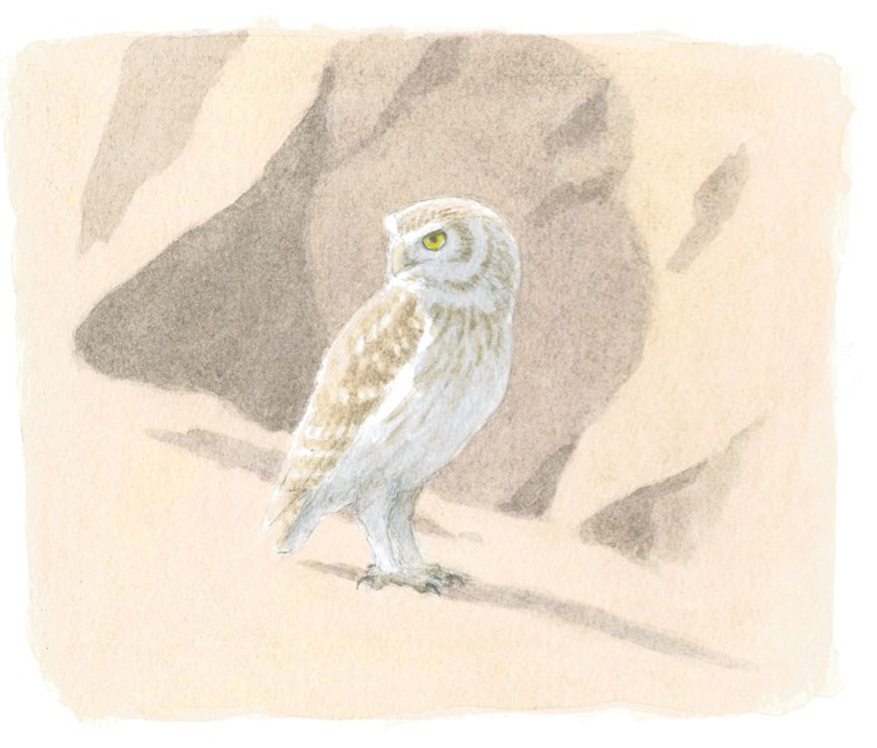
Håkan Delin
Pellegrino et al (2014) probably did not set out to split species or change names, but their work has two further implications for taxonomy. One is that the population from southern Italy and Sicily, which I always assumed to belong to noctua, lacks a scientific name. The other is that birds from Cyprus, traditionally included in subspecies lilith, are indistinguishable from the northern Italian-Balkan group that we are now calling noctua. It remains to be seen whether lilith from other parts of the range are genetically distinct, but an older study suggests they are possibly not.
Beyond Europe, we only have Wink (2008) to go on. He studied just 11 individuals, but included specimens of ‘indigena’ from Greece, lilith from Cyprus, Israel and Turkey, glaux from Israel and plumipes from Mongolia. He found almost no genetic difference between ‘indigena’ and lilith, and that glaux was a very close relative of both.
Arnoud once recorded a family of four fledgling glaux within earshot of the Atlantic, underneath a clifftop village in Morocco. Only a few sandy fields and a high dune separated the cliff from the sea. The nest was in a large cavity in the lower, sandy part of the cliff, and the young were already venturing outside. Arnoud had placed his microphones about 3 m from the nest and after a while, two of the owlets actually perched on them. One of them even proceeded to pull fibres out of the furry windshield. We’ll spare you the sensation of having the hairs plucked out of your scalp, but in CD1-69 you can hear how a juvenile Cucumiau might sound if it perched on your shoulder. At a certain point, Arnoud decided to rescue his equipment. One of the adults reacted with a form of cackling as he walked towards the nest (CD1-70).
CD1-69: Cucumiau Athene noctua glaux El Kasbah, Aysir, Safi, Morocco, 07:05, 19 June 2010. Begging calls of two juveniles, one of them perched right beside the microphones. Background: Barn Swallow Hirundo rustica, Sardinian Warbler Sylvia melanocephala, Zitting Cisticola Cisticola juncidis, European Goldfinch Carduelis carduelis and House Sparrow Passer domesticus. 100619.AB.070507.21
CD1-70: Cucumiau Athene noctua glaux El Kasbah, Aysir, Safi, Morocco, 07:09, 19 June 2010. Cackling of adult as recordist moved in to retrieve equipment. Background: Common Quail Coturnix coturnix, European Serin Serinus serinus and House Sparrow Passer domesticus. 100619.AB.070956.22
On other occasions too, when adult Cucumiaus felt their young to be threatened we have recorded sharp, staccato calls similar to cackling in Little Owl. In CD1-71, recorded in Oman, these particularly sharp calls silenced the young immediately. They gave no begging calls for several minutes afterwards. The family was living in a disused irrigation pipe, about 1.5 m above the ground.
CD1-71: Cucumiau Athene noctua Sohar, Al Batinah, Oman, 19:09, 13 April 2010. Begging of a juvenile, which is then silenced by an adult giving cackling calls. Background: Collared Pratincole Glareola pratincola. 100413.MR.190907.02
In Cucumiau, alarm calls usually have just a single note (CD1-72). The two-note version is rare in Cucumiau but common in Little. If Cucumiau does give a two-note alarm call, the first and second notes are much further apart.
CD1-72: Cucumiau Athene noctua Khatmat Milahah, Al Batinah, Oman, 18:50, 12 April 2010. Alarm calls of an adult at dusk. 100412.MR.185034.02
This book only covers the Western Palearctic, but the range of ‘little owl’ stretches all the way to the Pacific. It remains to be discovered whether several Asian taxa should be included in Little Owl or Cucumiau, or gain recognition as species in their own right.
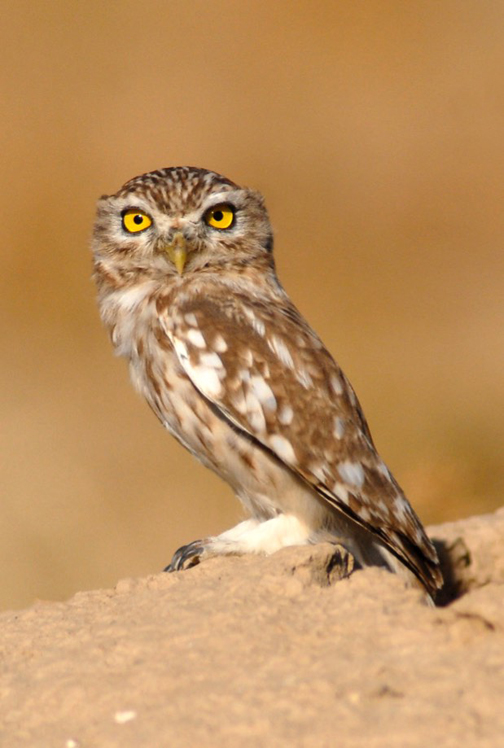
Cucumiau Athene noctua, Kyzylkol, South Kazakhstan, Kazakhstan, 11 September 2009 (René Pop)
Our next owl has a range that stretches just as far, but much further north. Its voice is one of the most beautiful sounds of the taiga.
